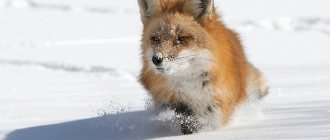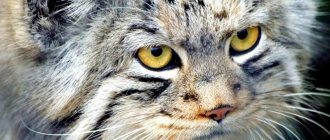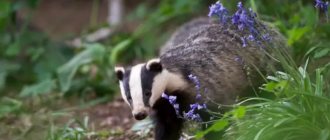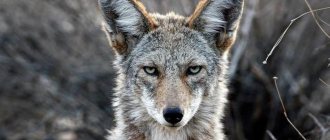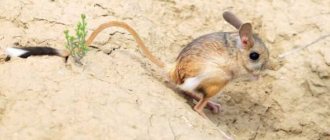07 April39384family of canids fennec predator
The fennec fox is the smallest and most unusual representative of the Canidae family. The fennec animal has a very unique appearance. This eared fox looks funny and very cute. The fennec fox is a nimble and active animal. Below you will find a description of the fennec fox and a photo, and also learn a lot of interesting things about this unusual animal.
Origin of the species and description
Photo: Lisa Fenech
The fennec fox, as a species, belongs to the order of predators, the canine family, and the genus of foxes. The name of the animal comes from fanak, which literally means “fox” in Arabic. First of all, fennecs stand out for their small size and disproportionately large ears. Experts, taking into account such a specific appearance of the animal, often identify a separate genus for it, called Fennecus.
With the development of science, it became known that the fennec has a smaller number of chromosomes than many foxes, which justifies its separation into a separate genus. In addition, they lack musk glands, unlike foxes. They differ in their lifestyle and social structure.
The species name in Latin, Vulpes (and sometimes Fennecus) zerda, literally means “dry fox.” The name arose due to the fact that the fennec tree lives in arid desert areas. The fennec's genetic relative is the bat-eared fox, which shares a common ancestor with it. The fennec fox diverged from common foxes about 4.5 million years ago. Moreover, many common morphological features with foxes and representatives of other “fox-like” species are explained by parallel evolution.
Habitat
Fenechs live in northern Africa: from the northern tip of Morocco to the Arabian and Sinai Peninsulas.
Geographically, the main population inhabits the central part of the Sahara Desert. By country, fennec lives besides Morocco in Algeria, Libya, Tunisia, Egypt, Sudan, Mauritania, Mali, Niger, Chad.
Sociality is one of the main characteristics of the behavior of little foxes
The harsh desert climate is the natural habitat for little foxes. Here they mostly stay close to small oases of grass and sparse bushes.
This is both shelter from the heat and some kind of food. Fenech lives in burrows with a complex structure: they have a lot of hidden passages. The animals sleep during the day, and at night they hunt and lead an active lifestyle.
Therefore, it is difficult to take a good photo of animals in natural conditions. But we know very well what fennecs look like, what they like to eat and how they behave thanks to domesticated individuals.
Interesting! The pads on the animal's paws are covered with fur: it protects them from hot sand during the day, helps to warm up on cold nights and maneuver on soft and loose sand dunes.
It is unknown how many fennec cats live in Africa. They are often caught for two purposes: to be sold as a pet or for their very valuable fur, which is valued even more than that of the ferret , otter and arctic fox .
Appearance and features
Photo: Desert fennec fox
The fennec fox is distinguished by its small body size. These foxes weigh only 1.5 kg, like small domestic cats. The height of the animal is very small, about 20 centimeters at the withers. The body length varies from 30 to 40 centimeters, plus the length of the tail is almost the same. The animal's paws are quite short and very reminiscent of a cat's. Interestingly, the toe pads on the paws are covered with fur. This allows fennecs to wander along the hot surface of desert soil or sand during the day.
Video: Lisa Fenech
The animal's muzzle generally resembles a fox's, but it is shorter, with a sharp narrowing closer to the nose. The ears of fennec foxes are very interesting: they are huge compared to the overall size of the fox, wide, but at the same time thin. Disproportionately large ears are necessary to protect the animal from overheating. These sizes of ears are necessary for organizing the body’s thermoregulation, since desert foxes do not have sweat glands. In addition, due to the large area of the ear, the hearing of these foxes is very well developed, and it allows them to hear any sounds of their potential prey in the sands.
The animal's teeth are small and very sharp. Therefore, the fenech is able to thoroughly chew the chitinous cover of insects. On the back the fur color is red, on the face and paws it is lighter, to white. Cubs are much lighter than adults; they darken with age. Fur covers the entire body. It is thick and quite long both on the body and on the paws. The hair on the tail is even longer, so it visually greatly increases its volume. In general, the fur gives the impression that fennies are much larger than they are. Outwardly, it seems that the fennec is heavier than its one and a half kilograms.
Walking with caution
Many people want to take their pets for a walk. They may be scared in another environment, so the animal should only be taken outside with a harness. Get used to walking in a harness gradually, first in a closed yard where there are no strangers. Gradually increase the time until you understand that the animal is not stressed and is accustomed not only to the place where it lives, but also for walks. To prevent escaping from home, you need to make sure your pet is in a safe place when leaving. Insect screens on the windows are not an obstacle for the fox.
Where does the fennec fox live?
Photo: Fennec Fox
For the fennec, its natural habitat is the zone of deserts, semi-deserts and steppes. It is accustomed to vast spaces with rare precipitation of no more than 300 mm per year, covered mainly with sand or stones, and areas with sparse vegetation. Sand dunes can be considered an ideal landscape.
Due to its habitat, the fennec fox is also called the desert fox. The lack of water does not scare him at all. These animals, of course, do not like to walk on hot surfaces, so they are active at dusk. They try to dig their shelters near sparse desert vegetation.
For example, the roots of a bush are quite suitable for digging a hole among its roots. The burrows of fennec foxes are special: they have several passages and branches. Approximately in the middle between them, fennecs line their bed with straw, dust, fur or feathers. If an uninvited guest enters one of the passages, the animal can leave the shelter through another exit.
The desert fox's habitat is small compared to the ranges of other foxes, which are distributed on almost all continents. Fenech lives in North Africa at least 14° N latitude. in its inaccessible areas and on the Arabian Peninsula.
You can meet the animal in several countries:
- Tunisia;
- Egypt;
- Algeria;
- Libya;
- Morocco;
- Mauritania;
- Republic of Chad;
- Niger;
- Sudan;
- Israel.
The largest populations of desert foxes are found in the Sahara Desert.
Interesting fact: the fennec is a sedentary animal; it does not change its habitat even with the change of seasons.
Adaptive capabilities of fennec cats
The fennec fox is so well adapted to life in the desert that it can live without separate water. Instead, fennec foxes get most of their water from leaves, roots, fruits, eggs, and animal prey they find to eat. They can also collect condensation where the fennecfish lives, in their den.
They have a thick, sandy coat that keeps them warm at night and reflects sunlight during the day. They even have fur on their legs to protect their feet from the scorching earth. The thick fur also gives the fox extra traction when maneuvering through loose sand and dunes.
Large daytime predators such as birds of prey or hyenas can catch them if foxes venture outside the burrow, so staying inside during the day is smart for this small creature. Their nocturnal lifestyle protects them from predators. Thermal reflective wool also provides excellent camouflage in the environment.
What does the fennec fox eat?
Photo: Little fennec fox
Fennec foxes are indiscriminate eaters. This is due to their habitat. In deserts you don't have to choose, so they eat everything they can find. So, any dug up roots can serve as both a source of nutrients and a source of a small amount of moisture. All the fruits and berries found are also eaten by fennecs, but there are few of them in deserts, so they are not the main food of foxes. Another peculiarity of the animal is that it can be without water for a very long time, and it receives the necessary liquid from the berries and plants it eats.
It’s not for nothing that nature endowed fennec foxes with such huge ears. Together with excellent hearing, they detect any rustling noises made by even the smallest vertebrate animals and insects in the sand or underground, so they quickly tear them apart and then chew them.
They eat with pleasure:
- small rodents (vole mouse);
- lizards;
- chicks.
The animal also loves to eat eggs. Very often, the fennec eats the remains of other people's prey and animals that have died a natural death. Carrion can become even the most abundant meal, especially if the remains of a large animal have been discovered.
Interesting fact: the fennec fox stores excess food in reserve, but unlike the same squirrels, the fennec fox perfectly remembers its hiding places and their locations.
Nutrition
At home, the fennec cat's daily diet must include vegetables and fruits.
In the desert there is no time for selectivity in food. Therefore, the fenech, although more than once called a predator in this article, is in practice an omnivore.
And everything he eats is somehow dug out of the ground. The ability to dig in general greatly helps foxes in life: from digging holes to chasing some tasty insect or rodent.
Interesting! The main enemy of the fox is the African eagle owl. Scientific observations have not revealed larger predators preying on small foxes.
Fenech hunts alone. Almost everything is eaten: fruits, roots, eggs and small vertebrates, insects and even carrion.
Thanks to its ears, the fox catches even the quietest prey. The Fennec cat's body is designed in such a way as to be content only with liquid obtained directly from food.
Therefore, animals can live for a long time without a constant source of water. By the way, fennec foxes sometimes stock up on food.
Features of character and lifestyle
Photo: Sand fennec fox
Fennecs are very playful and inquisitive. But at the same time, they are very careful and secretive. During the day, they are usually energetic and very active about 15% of the time, calm and relaxed about 20%, and sound asleep the rest of the time.
It is believed that the fennec's favorite activities are digging holes and jumping. For example, during a hunt, he is able to jump up almost 70 centimeters. In addition, the length of his jump can reach one and a half meters, which is quite a lot for his small size.
Hunting, like all other main activities of the animal, occurs mainly at night, when the ambient temperature drops to acceptable values. Among the characteristics of desert foxes, it can be noted that their thick fur protects against the cold, but the fennec begins to freeze even at +20 degrees Celsius, which manifests itself in the fact that it begins to shiver from the cold. The fennec tries to hunt alone.
To protect itself from the sun, the fennec can dig a new shelter every night. It digs holes so easily that it can dig a tunnel up to six meters long without any visible effort overnight. The fennec can bury itself in the sand not only for protection from the sun, but also if it senses any danger. Moreover, it is capable of burrowing so quickly that it would seem that the animal was just here, and now it cannot be found, as if it was not here right away. They peek out of their burrows slowly, first move their ears, listen, sniff the air, and only then little by little they poke out from under the sand.
They have very well developed night vision. Overall visual acuity is increased due to the presence of a special reflective retina, which helps to illuminate the observed objects. At night, the gaze is very similar to that of a cat, with the exception that in cats we are accustomed to seeing a green reflection of light from the eyes, while in fennec foxes the eyes glow red.
Description of the animal
The size of this animal is smaller than that of a cat. At the same time, he has pointed facial features, huge ears, and eyes. The ears are more than 15 centimeters long.
However, this is not a disadvantage, but an advantage of the animal, since it is the ears that help it successfully hunt for prey, and in hot weather they provide heat transfer.This is a nocturnal animal with eyes adapted for darkness due to the presence of a special retina, which glows red in the dark.
The animal's fur is quite thick, slightly raised, red on top, snow-white below. The loose tail is quite dark in color at the end.
Social structure and reproduction
Photo: Pygmy fennec fox
Fennec foxes are social animals. They usually live in small groups of a maximum of 10 individuals. Groups are formed along family lines and usually consist of one full-fledged married couple, their offspring who have not reached puberty, and, sometimes, several older children who have not formed their own clans. Each group occupies its own specific territory, the boundaries of which are marked by fennecs with urine and excrement. Dominant males in a group urinate more and more often than other individuals. Desert foxes are active defenders of their litter and their territory.
Fennecs are very sociable. Like other social animals, they use several types of communication - visual, tactile, and, of course, smell. Games are of particular importance in maintaining hierarchy and social structure in a group. The nature of the games can change within one day, as well as over the seasons. Animals have very developed vocalization. Both adults and puppies, in order to communicate with each other, can make chirping sounds, sounds similar to whimpering, they can bark, whine, growl and squeal. The fennec's howl is short, but loud.
Fennecs are monogamous animals. During the breeding season, which usually lasts for 4-6 weeks, males become more aggressive, and at the same time begin to more actively mark their areas with urine. Reproduction occurs once a year, usually in January-February. If the offspring died for some reason, then the adults can re-give birth to more puppies, which often happens if there is an abundant food supply.
Male fennecs are excellent fathers. They help the female protect her cubs, but the female does not allow them to contact the pups until they begin to play on their own near the entrance to their den. This usually happens around five to six weeks of age. The male brings food to the burrow. Due to the fact that the female behaves aggressively and protects her puppies from him, the male does not enter the den, but leaves food nearby.
The rutting period for fennecs occurs over two months. But in females, estrus does not last long - only two days. The female communicates to the males that she is ready to mate by positioning her tail. She takes him to a horizontal position in one direction.
How do animals grow?
Offspring are born once every twelve months. The next batch is reproduced only if the first one dies.
For a month, the mother does not leave the babies, and also does not let anyone near them. The male also has no right to approach the puppies; he is only allowed to deliver food, but he does not enter the burrow for fear of an aggressive female.The beginning of love games occurs in winter, however, females are in heat for no more than a few days. Pair formation occurs over a long period of time. Each couple has a plot.
- Detailed description with photos of all animals included in the Red Book of Russia
Zebra - habitats, appearance, diet and behavior, life cycle + 94 photos
Leopard - habitats, life cycle, rutting season and lifespan + 118 photos
From the age of one month, babies begin to lick out of the mink, examining the environment. However, at first they do not go far from the shelter. Only from the age of three months do they decide to move as far as possible from home. By this period, they are no longer fed with mother's milk.
Ten months later, these mature animals are ready for adventure and mating. Many leave their families to form their own clans. But some stay with their parents, helping raise generations.
In desert conditions, the fennec, a photo of which can be seen on the website, lives for about seven years. However, in a zoo, as well as in a cozy home environment, life expectancy can reach several decades.
Natural enemies of the fennec fox
Photo: Long-eared fennec fox
Fennecs are quite dexterous and nimble animals that are active at night. In the wild they have practically no enemies. Potential enemies may include jackals, hyenas and sand foxes, whose habitats overlap with those of the fennec fennec. But their threats are only indirect. Excellent hearing allows fennecs to detect a stranger in advance and hide from him in their lair.
The fennec's main enemy is the eagle owl, which, despite the fennec's agility and speed, is capable of hunting the desert fox. The eagle owl flies silently, so it can grab an unsuspecting cub near the hole, even though its parents may be nearby at that moment.
Also, the desert lynx - the caracal - is considered to be the enemy of the fennec, but there is only indirect evidence of this, since no one has seen eyewitnesses of its hunt for the fennec. In fact, the only real enemies of the desert fox are the person hunting it and small parasites, such as helminths.
Fennec at home
Today, people are increasingly keeping various animals from the wild at home. Exotic lovers are no longer interested in having a cat or dog at home. Nowadays, few people will be surprised if you have an owl, a puma or any other animal that does not fall into the standard list of pets. What can we say, now even an ordinary red fox is kept at home. The fennec fox is no exception; it can often be found among pets.
The unusual appearance of this eared fox immediately attracts the eye. The compact size and cute face immediately give rise to the idea of getting such an animal. But the fennec fox is not the easiest pet. First of all, we should not forget that this is a nocturnal animal that will interfere with sleep. Secondly, the fennec is a wild animal, which is quite difficult to train and train, so you will have to spend a lot of time and effort on training.
Another important issue is creating conditions for the fennec. To keep a fennec at home you will need a lot of space, sand and a warm climate. It’s not difficult to feed the long-eared fox, because it is quite unpretentious and almost omnivorous. The main thing is that the diet contains meat, eggs, vegetables and live food (lizards, grasshoppers). Despite the ability to go without water for a long time, it is still worth making sure that your fennec cat always has a bowl of water. The issue of caring for the beautiful and fluffy fur of a fennec cat includes a combing procedure, especially during shedding.
Remember that the fennec animal cannot tolerate low temperatures. He is very susceptible to colds, from which he often dies. It is also worth noting that due to the exotic nature of the animal, it will be quite difficult to find a veterinarian who can give competent advice. Subject to the conditions of keeping, proper attention and education, you will receive a smart, affectionate and sociable pet. It is curious that of all domestic animals, the fennec fox gets along best with cats.
Don’t forget to subscribe to updates on our website and join us on social networks (Vkontakte, Odnoklassniki, Instagram) so you don’t miss anything and always stay up to date with all the news!
Don't forget to share with your friends!
How to create comfortable conditions at home?
Before getting a fox, you should understand that the fennec is first and foremost a predator. It is possible to grow and tame it at home, but this will require some effort and patience. In addition, it is necessary to create favorable living conditions for the animal, provide it with a proper, balanced diet and proper care.
Cage and your own corner
Since the biological activity hours of humans and fennec cats do not coincide, it is better to give the animal a separate room or create a corner outside your bedroom so that you can sleep at night. A very important point in keeping these little ears is the air temperature in the room where they live. The room should be very warm or even hot, otherwise the little fox will start to get sick, and this can result in a big problem, since the animals get sick seriously and for a long time, and it’s not so easy to find a veterinarian who knows how and with what to treat them.
Since the animal loves to dig, it is advisable to organize a play area with sand for it; if this is not done, he will make tunnels in things and furniture, so ensuring the pet’s leisure time is clearly in the interests of the owners. The safety of the fennec cat plays a big role; his excessive curiosity and activity can play a cruel joke on him. Therefore, always close windows and doors and hide all fragile items. Make sure that the wires are not accessible to your pet fox, as the fennec will definitely be interested in them.
To avoid unpleasant situations, it is better to arrange an enclosure or cage for the animal, and let it out for walks around the apartment only under the supervision of the owners. Of course, this will require additional costs, but your home will be in order and you will be able to calmly go about your business without worrying about what your pet has done.
Feeding the little animal
In order for the fox cub to feel good, it needs to be provided with a balanced diet. He is not picky about food; You can use dog food, which contains everything your eared animal needs. If you give preference to natural nutrition, then your diet should include fruits and vegetables, eggs, chicken meat and cereals. A real delicacy for them are lizards, insects and small rodents, as well as dates and figs.
It is best to observe the animal for some time, offering it to taste different foods, and identify its taste preferences, since they can be individual.
Pet care
One of the important aspects of care is training the fox cub to use the tray. The fact is that animals can mark the territory and after that an unpleasant odor can concentrate in the room. So, from childhood, you need to teach the animal to go to the toilet in a certain place. Breeders have mixed opinions about the difficulty of such training: some say that fox cubs very quickly master going to the litter tray, others say that there are certain problems with this, but in the end everyone overcomes them. In no case do you forget that the eared cat has the finest hearing; therefore, it is better to avoid loud sounds and conversations in its presence. The animal's fluffy coat requires special attention - the fur needs to be combed regularly with a special brush, which brings great pleasure to the fennec cat. Every year the animal must be vaccinated against rabies.
Helpful information
An animal from a good nursery in the USA costs approximately 2 to 3 thousand dollars. In other countries, the price may be higher due to transportation and purchasing the necessary documents. The high cost is due to the difficulties in breeding and growing.
The following points need to be remembered:
- If you are interested in the smallest fox that you can keep at home, then you should not confuse the two species: there is a fennec fox, and there is a big-eared fox.
- Make sure keeping a pet fennec fox is legal where you live.
- Be prepared that the animal may be unclean.
- Make a cage and cover any holes through which the animal can escape.
- Keep your pet in your own home, but not in an apartment or home shared with someone who does not accept the phoenix as a pet.
- Ask the breeder about vaccines and find a good veterinarian.
Expect lots of energy, demandingness, talkativeness, loudness, independence, and potential chaos. A domestic fennec fox is for energetic and patient people.
Interesting Facts
- During his expedition, Uwe George fell in love with the charming fennec cat so much that he decided to take him with him to Hamburg. The fox, whom the reporter took in, lived in a separate room filled with stones and sand brought from the Sahara. Numerous jerboas lived under the surface layer of sand; from time to time they emerged from their shelters and began to jump - gracefully, like tiny kangaroos. The entrance to their burrows was small holes through which special tubes passed - heating channels. Although the fenech during the hunt used all his cunning to grab the jerboa: he hid, sat motionless for hours in ambush near the mink, pretending to be asleep or completely indifferent, he rarely managed to catch the jerboa. According to Uwe George, these scenes played out by the fennec were very similar to the ups and downs of the famous cartoon “Tom and Jerry”.
- The most famous domesticated fennec fox is the fox in Antoine de Saint-Exupéry's novel The Little Prince. Antoine de Saint-Exupery was inspired to create this character after meeting a fennec cat in the Sahara in 1935.
- The fennec is especially revered in Algeria, where it is the national animal. The Algerian national football team is nicknamed "Les Fennecs" (Fennecs or Desert Foxes). In addition, the fennec is depicted on the Algerian ¼ dinar coin.
- Fenech is a symbol of Tunisia's ecology. Figures of this animal in a blue and white suit are ubiquitous in almost every city in this country.
- Fennec is the logo and codename of Firefox for mobile.
Video
How does a fennec fox hunt?
Although desert foxes live in families, they, like their relatives, prefer to hunt alone. During the hunt, the animal completely relies on its hearing, sight and smell. These same feelings serve the Fennec to warn of danger.
Our common fox, the arctic fox or arctic fox, the corsac fox of the steppes of Asia, the gray American fox, the broad-nosed fox of southern Africa - they all have almost the same habits. In most cases, fox hunting comes down to searching for prey by smell and then hiding it.
And the fennec cat’s acute hearing, vision and sense of smell allow him to hunt not only birds, animals, but even insects. His silent, creeping step allows him to catch the most distant, quietest sounds on the move. If some air vibration gets into his ears, they expand towards the noise. The desert fox pauses for a moment and then begins to approach even more cautiously in the direction of the noise. Her eyes pierce the thick darkness of the desert. From a distance she can see a sleeping hazel grouse (steppe pigeon), a lark or even a fat locust. He eats her too. True, with less pleasure than a bird or animal, but still he will not pass by if he hears its rustling. In the desert you have to put up with everything; there is a lot of sand, stones and heat, but not food and drink.
For all the tirelessness of the fennec, for all the acuteness of his feelings, the enormous space over which the rare animal kingdom of the desert is scattered creates great difficulties for the animal. You can drive in the Sahara for hours, whole days, and not see a single bird. And this rarity of the population serves as the best protection against enemies. It is not so easy and not so often that the fenech manages to feast on the hot blood of sandgrouses or larks. But the hazel grouse is a desirable prey for the fennec. If an animal senses with its nose that it has crossed the trail of a hazel grouse, it will immediately sniff out the entire place and follow the subtle scent that remains from this bird’s daytime walk. There is nothing here to distract the attention of this amazing bloodhound! The desert fox will persistently follow the footsteps of the hazel grouse right up to its overnight stay or the place from which it flew away. This kind of failure often happens. But she does not discourage the fennec. It happens that during these searches the wind will carry the scent of sandgrouse sleeping nearby, and then the same animal’s nose will lead straight to the desired prey. By smell, the desert fox not only finds sandgrouse, but even desert larks and common larks. It happens that these small birds also fall on the fennec's teeth. They are identified not only by their smell, but sometimes also by the noise they make in their sleep when they change position, or by an involuntary cry, song, or flapping of wings. Once any noise from the movement of the bird fell into the huge ears of the fennec fox, the bird died.
Fenech will lower his body to the ground and will slowly, for a long time, sneak towards the noise. From afar, his eyes will notice somewhere under a bush the tiny figure of a bird, which, unaware of the danger, continues to sleep serenely. The fenech will choose the bush or depression closest to it in order to grab its victim in its teeth in one leap. But he applies this technique of hiding prey to sleeping birds. He hunts jerboas and voles differently. Here he not only hides, but also chases. The Saharan vole and jerboa, like the fennec fox, are nocturnal animals. They also have keen hearing and keen eyes. The animal does not always manage to take them by surprise. However, the fox often catches the jerboa, despite its amazing jumps. The whole thing is spoiled for the jerboa by his hare-like ability to jump in different directions to listen to the enemy. But this technique with the fennec tree does a disservice to the jerboa. The desert fox carefully watches the jumps and runs straight to the place where the jerboa lands. From random jumping and fear, the jerboa soon gets tired and becomes prey to the less dexterous, but more cunning fennec.
It is much easier for the fennec to deal with voles. They have only one salvation: to hide under the roots or crawl into burrows. But this does not save much from a persistent pursuer. The animal digs shallow holes, and a small vole ends up in its stomach.




